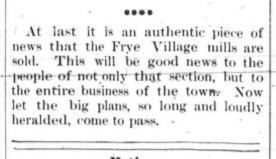Before Shawsheen Village Frye Village Stories: The end of the Frye Village degreasing concern
By 1906, the Frye Village degreasing plant was in trouble.
Between January and May, the Townsman reported on multiple lawsuits again General Degreasing for lack of payment and breach of contract. In September, the American Wool & Cotton Reporter ran the anonymous August 1, 1906 letter to the editor, “Degreasing Wool a Failure,” by “Merrimack.”
“The efforts to make a commercial success of degreasing wool, whether by using naphtha or other solvents, have in every case proven a failure, despite claims by one Massachusetts corporation.”
The letter outlined some of the management issues, confirmed through other research, that lead to the failure of the Frye Village plant. Disagreements with owners that resulted in others being “frozen out” likely refers to the troubled Augustus Clason. References to stock brokerage firm taking over from experienced wool manufacturers, lawsuits between parties, and difficulties with creditors all relate back to stories reported elsewhere.
Waiting for news...
Based on this small notice in the September 9, 1906 Andover Townsman, rumors and stories about the degreasing plant had been flowing through Frye Village.
“At last it is an authentic piece of news that the Frye Village mills are sold. This will be good news to the people not only of that section, but to the entire business of the town. Now let the big plans, so long and loudly heralded, come to pass.”
At this point we can only imagine what the long-heralded plans were hoped to be!
But neighbors had a long wait. The Frye Village mill didn’t sell until 1909.
The Mortegee’s Sale notice appeared in the June 9, 1909 Townsman, still listing the
“mortgage deed given by Robert Brailsford to the Smith and Dove Manufacturing Company, dated July 21, 1902...will be sold at public auction upon the premises situation in that part of Andover Mass. known as Frye Village.”
So for all the twists and turns and changes in management, the deed to the property had been held by one company the entire time. Along the way, the business operating within the mill might have been owned by different companies: Babcock & Howland, American Degreasing, General Degreasing.
What comes next?
If you’ve been following the story, you might remember that in July 1909 the mill property was purchased by Mr. J.E. McGovern, the well-known horse undertaker of West Andover.
Frye Village residents’ concern that Mr. McGovern would use the mill for rendering and soap production was allayed a month later, in August 1909, when Mr. McGovern sold the property to George Binney, agent for William M. Wood.
By the 1908 Andover Street Directory, Charles Howland is no longer listed as living in Andover and in September 1910, the Howland house at 77 Main Street was in foreclosure.
And so ended seven years of the degreasing company in Andover.
What happened to engineer and inventor John T. Morse?
John T. Morse had already moved on to his next firm. In January 1905, in a special “State Capital News” from Albany, the Brooklyn Times Union reported that with another $250,000 in capital investments, Morse and his partners formed United States Extracting and Refining Co, “The company is to extract grease and by products from wool and other sources.”
I wonder what happened this time.
Moving on from our deep dive into the Frye Village wool degreasing business - which I hope you've enjoyed! - we'll explore a more Andover-based business that occupied the same Frye Village mill site: the Hardy Brush Company.






